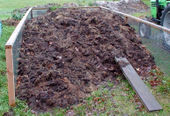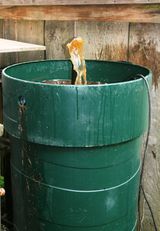Difference between revisions of "Compost"
| Line 37: | Line 37: | ||
File:Compost heap set up in layers.JPG|Compost heap set up in layers | File:Compost heap set up in layers.JPG|Compost heap set up in layers | ||
</gallery> | </gallery> | ||
| + | |||
| + | == Garden Journal == | ||
| + | : ''See also [[Garden Journal]] for a list with all pages with a garden journal section.'' | ||
| + | [[File:Compost tea 120621.JPG|160px|left]] June 21, 2012 - Yesterday i began again with making compost tea. I've done this long ago, with a mix of Effective Microorganisms<ref>[http://en.wikipedia.org/wiki/Effective_microorganism Effective microorganism - Wikipedia]</ref> as starter. Now i'm doing it with my own compost. A bucket of compost in a barrel of water, add a sugar solution (molasses is best), lava flour for the minerals, some seaweed lime, and blow oxygen into the mix with a pump. After one or two days the oxygen-loving microbes have multiplied many times and the mix is thinned with five parts of water. Then sprayed over crops and land where the microbes will protect the plants against disease and will start working on the organic material in the soil, releasing and adding many nutrients for the plants. Compost tea can also be used as a compost starter, or to clean your pond.<br clear="all"/> | ||
== See also == | == See also == | ||
Revision as of 04:02, 22 June 2012
Topic in Gardening courses
Chunks of information
- Important to get good compost is to have the right mix of materials. I use soil, animal manure, grass clippings, weeds that were taken out from the garden, used coffee grounds, straw etc.
The bacteria that transform organic material into compost need oxygen, water and the right mix of carbon (C) and nitrogen N). The ideal mix is C:N = 30:1. Fresh grass clippings have an average ratio of about 15 to 1 and dry autumn leaves about 50 to 1 depending on species. Mixing equal parts by volume approximates the ideal C:N range. Some more examples: sawdust 200-750:1, cow manure 10-30:1, soil 12:1, etc. See this article for more details http://www.grow-it-organically.com/compost-ingredients.html
- I also always add agricultural lime, lava flour and clay grains (bentonite). I scatter a few hands full of these materials on top of each layer that ideally already has a perfect or near-perfect mix of C:N.
- After about 1 to 2 months the pile can be re-handled. Inside the pile already much of the compost is ready and i throw it on top of a big sieve (you can see it in the photo) to separate the fine material from the rough parts. What doesn't go through the sieve goes back on the compost heap.
- Liquid cow manure contains substances that are poisonous for a healthy life of micro-organisms in the soil. When however the cow manure is composted it can be made into a fertilizer that smells pleasantly and is good for the soil.
- "Adding oxygen & carbon to liquid manure enables microbes to feed on the ammonia in the manure." (http://eap.mcgill.ca/MagRack/SF/Summer%2091%20M.htm)
- "Aerobic bacteria manage the chemical process by converting the inputs into heat, carbon dioxide and ammonium. The ammonium is further converted by bacteria into plant-nourishing nitrites and nitrates through the process of nitrification." (http://en.wikipedia.org/wiki/Compost)
- I got 3 m3 of old liquid cow manure in a cellar. We added 6 m3 of saw dust, which contains mainly carbon and minerals but very little nitrogen. The photo shows these substances. They will be mixed further and then used on a compost heap, adding other organic materials that aid the composting process.
- In nature cows defecate 'proportionally,' meaning that they leave small heaps of manure in the grass. Animals like the cockchafer pull the manure deeply underground. Grass dies and mixes with the manure. Always oxygen is present abundantly and the substance composts in a natural manner feeding the soil. But present-day farming produces big quantities of liquid manure. There's little oxygen in it, almost no carbon content and the healthy micro-organisms that would normally break down the manure cannot do their work.
- When farmers inject a field with big tanks of liquid cow manure, you can often see seagulls visiting the place. Why is that? The rain worms, if they are still present, don't like the manure and try to escape to the surface, where they fall prey to the birds. When a field is treated too frequently in this way, the rain worms all die.
- Goat manure is quite different as it comes in small droppings and it is mixed with straw when it leaves the shed. I also put it on the compost heap. I don't know how it is on big goat farms, they probably have some liquid manure too but it will be thinner than cow manure and goats don't drink very much.
- he process of transforming the materials by micro-organisms works much better in a big heap than in a smaller one. More warmth is generated. It's also important to cover the heap with a layer of straw or something similar so the heat is kept inside.
- Compost heaps can finish quickly when materials are added in the right mix, and also all that's necessary for the micro-organisms to do their work. Heat is generated that way inside the heap and accelerates the process. Sometimes the heap gets too hot on some places, but it will still make good compost there and it's only in some parts of the heap deep inside and only for a shorter period.
- I never need to turn my compost heaps. I collect ingredients in advance, let them lay for several weeks. Then i carefully build up the compost heap, layer upon layer, green stuff, brown stuff, soil, extra ingredients. In that way the compost heap makes finished compost without the need for turning the heap upside down. In the summer the compost finishes in about 2 to 3 months. In the winter it takes ca 6 to 8 months.
C-N ratio
- Compost calculation for grass as main component - Fresh grass has N:C = 1:15 - Ideal is N:C = 1:30 - So we need the amount of C doubled. - When straw or sawdust is added, this is almost entirely C. Add the same weight of sawdust or straw to the grass and it brings the relation on 1:30 - Add some soil (1:12) for getting the right structure.
My practical formula for making good compost
- Pile up a heap of compost in layers
- Two hand widths of green material (N rich, fresh grass cuttings, fresh weeds from the garden, animal manure)
- One hand width of brown material (C rich, straw, saw dust, etc.)
- The thickness of a flat hand of garden soil or mature compost
- Topping of a spray of lava flour, organic lime, bentonite (ca one hand full of each per m2)
Gallery
Garden Journal
- See also Garden Journal for a list with all pages with a garden journal section.
June 21, 2012 - Yesterday i began again with making compost tea. I've done this long ago, with a mix of Effective Microorganisms[1] as starter. Now i'm doing it with my own compost. A bucket of compost in a barrel of water, add a sugar solution (molasses is best), lava flour for the minerals, some seaweed lime, and blow oxygen into the mix with a pump. After one or two days the oxygen-loving microbes have multiplied many times and the mix is thinned with five parts of water. Then sprayed over crops and land where the microbes will protect the plants against disease and will start working on the organic material in the soil, releasing and adding many nutrients for the plants. Compost tea can also be used as a compost starter, or to clean your pond.
See also
External links
- Compost Wikipedia
- COMPOSTING & PLANT NUTRITION Section of organic gardening course
- Compost Mix Calculator
- Managing liquid manure through micro-aeration
- The Carbon:Nitrogen Ratio (C:N) "Decomposition of organic materials in your compost pile is greatly increased when you create the proper balance between the carbonaceous materials (called BROWN because they are dry) and the nitrogen-rich materials (called GREEN because they are more fresh and moist)."






